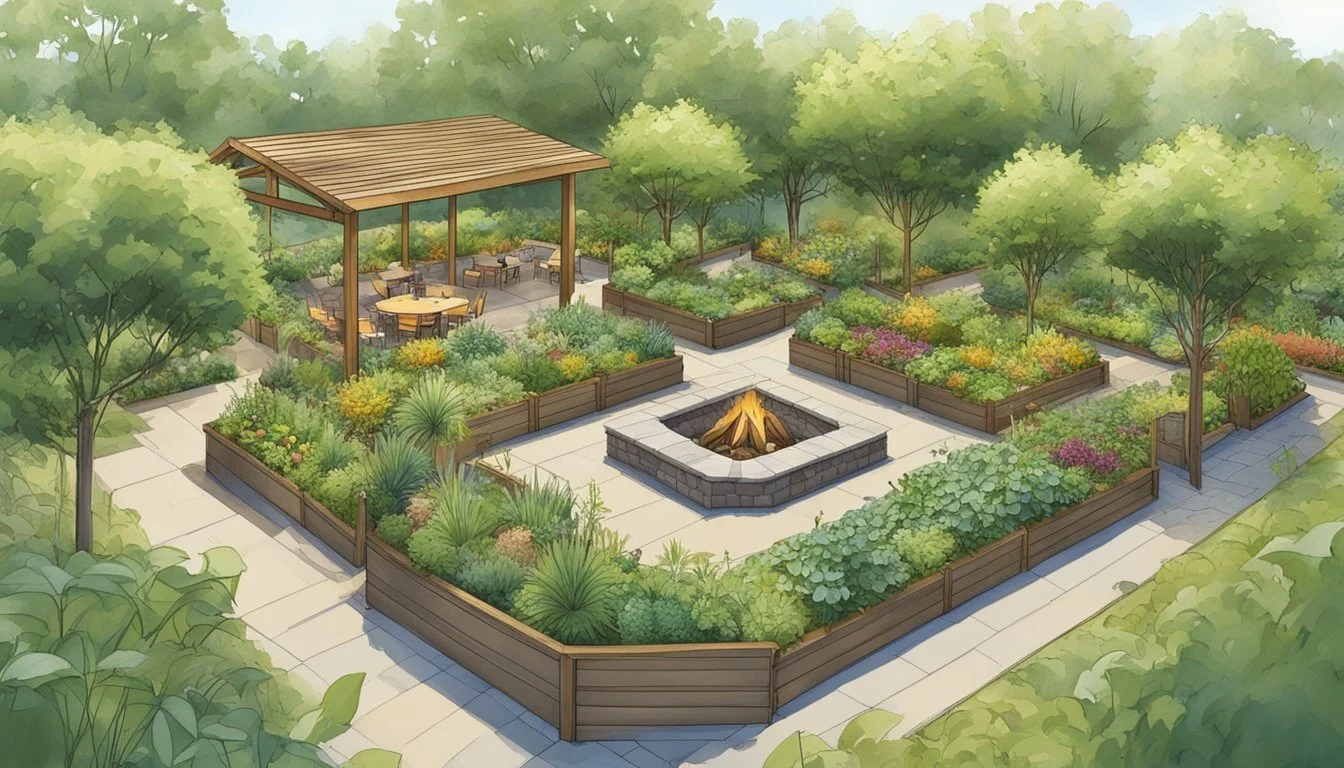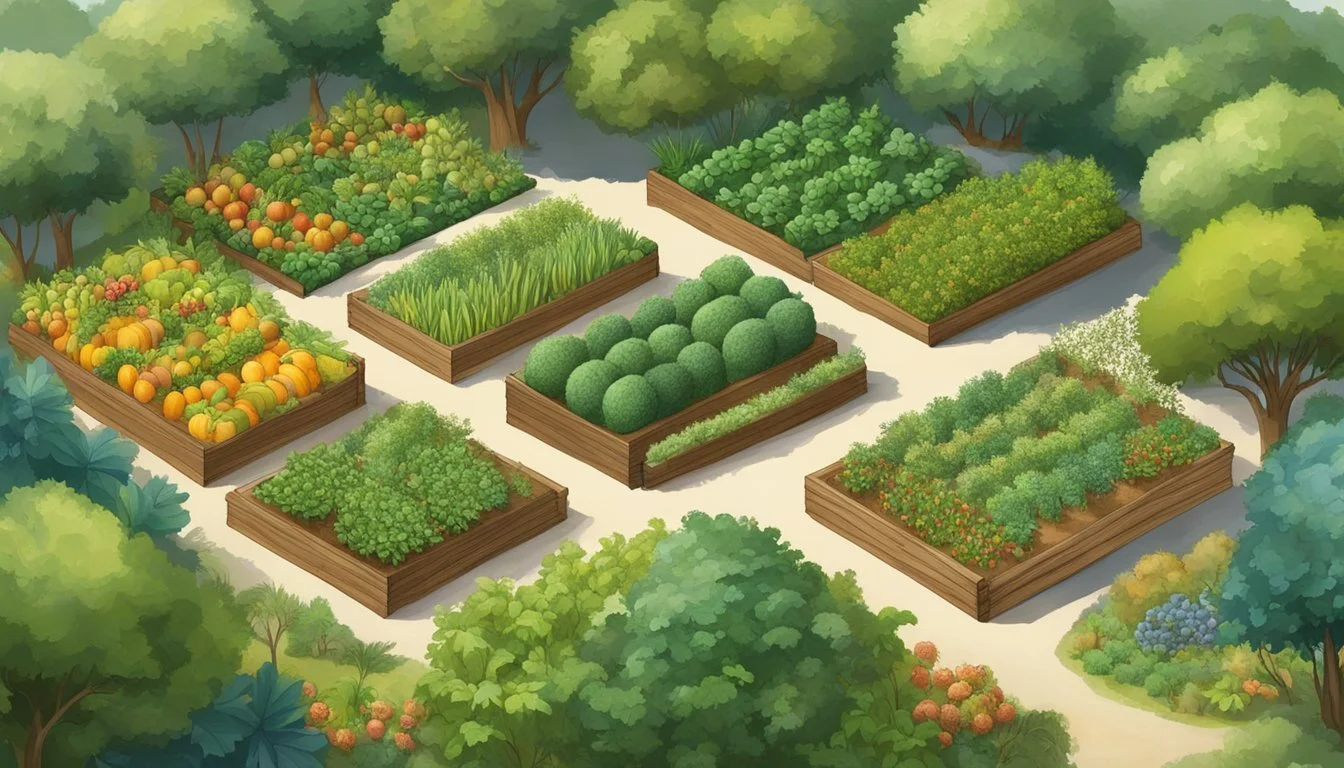Implementing a Homestead Food Forest
A Step-by-Step Guide
A homestead food forest represents a pinnacle of sustainable agriculture, embodying the resilience and diversity of a natural ecosystem within the confines of a managed backyard or farm. This method of farming goes beyond traditional agriculture by creating a layered system of trees, shrubs, and ground cover that mimics the structure of a wild forest. In a food forest, each layer is not only chosen for its yield of fruits, nuts, or herbs but also for its contribution to the health of the whole system through biodiversity, soil improvement, and water retention.
The concept of a food forest is rooted in permaculture principles, aiming for minimal input and maximum benefit. It is designed to be self-sustaining, requiring less work and fewer resources than conventional gardens or farms over time. The layers in a food forest work symbiotically: tall canopy trees offer shade, smaller fruit and nut trees provide food, shrubs fill the middle layer, and ground cover crops inhibit weed growth and protect the soil. This synergy results in a bountiful and resilient ecosystem capable of producing food for the homestead and habitat for local wildlife.
Implementing a home food forest starts with understanding the intricacies of the land and its native ecosystems. This initiative involves careful planning and patient development, as a food forest grows and evolves over many years. Homesteaders interested in creating such a system must consider the specific needs of their region, selecting plant varieties that will thrive in their climate and soil conditions. By prioritizing local and hardy species, they can ensure a food forest that is not only productive but also a testament to the robust potential of sustainable agricultural practices.
Understanding Food Forests
A food forest is an agricultural practice which mimics a natural ecosystem by integrating perennial plants and trees to create a sustainable, production-oriented garden. This section will dissect the core fundamentals, structural composition, and the inherent benefits of adopting a food forest ecosystem for homesteading.
Principles of Permaculture
Permaculture is the foundation upon which food forests are built, emphasizing the harmonious integration between humans and nature. The principles of permaculture focus on ethical design, sustainability, and conservation of resources. They advocate for diversity, resilience, and the utilization of local materials and energy-efficient methods.
Layers of a Food Forest
Every food forest is stratified into distinct layers, each playing a vital role in the garden's overall function. These typically include:
Canopy: This top layer consists of large fruit and nut trees.
Understory: Made up of smaller trees and shrubs, often berry-producing.
Herbaceous: Consists of non-woody, perennial plants and herbs.
Rhizosphere: The root zone, which includes root crops and fungi.
Soil Surface/Groundcover: Low-growing plants that suppress weeds and retain soil moisture.
Vertical Layer: Climbers and vines that utilize vertical space.
Each of these layers supports the others, contributing to a self-regulating ecosystem.
Benefits of a Food Forest Ecosystem
Food forests offer numerous advantages for the homestead. They provide a diversity of yields ranging from fruits and nuts to medicinal herbs. The design of a food forest encourages biodiversity, promoting a healthier plant and animal habitat. Furthermore, this type of ecosystem is naturally resilient to pests and diseases due to its diversity and mimicking of natural systems. It also possesses a self-fertilizing capacity which reduces the need for external inputs, hence maximizing resource efficiency.
Planning Your Homestead Food Forest
Effective planning is the cornerstone of establishing a productive food forest on a homestead. Attention to detail during the planning phase ensures that the food forest is not only sustainable but also harmonizes with the local ecosystem while meeting the nutritional and aesthetic goals of the homesteader.
Design and Layout
In designing the layout of a food forest, it's essential to think about the spatial relationship between plants. Start with the largest elements, such as fruit trees and nut trees, ensuring sufficient space for their mature canopy spread. This not only helps in maximizing sunlight and reducing competition but also facilitates ease of access for maintenance and harvest. A commonly suggested rule for spacing is to plant trees approximately a crown's diameter apart, or more to accommodate understory plants.
Site Selection and Analysis
Site selection is crucial, as it should take into consideration the local climate, soil conditions, and topography of the land. Analysis of the site's resources — such as sunlight exposure, wind patterns, and water availability — will inform the suitability of the location for various plant species. A site with steady rainfall, adequate sunshine, and manageable winters, resembling USDA Zone 7 conditions, is often ideal for a variety of plant species.
Selecting Suitable Plant Species
Selecting plants appropriate for your climate and soil is key to a thriving food forest. The choices should include a variety of species that fulfill different functions such as nitrogen fixation, pollination, and providing a continuous yield throughout the season. Incorporating local species can aid in maintaining biodiversity and sustainability. For instance, in areas that emulate a zone 7 climate region, plants must be chosen for their ability to thrive in temperate conditions with moderate winters.
Soil Preparation and Management
The foundation of a successful homestead food forest lies in the meticulous preparation and management of the soil. Rich, healthy soil underpins the biodiversity and productivity of the ecosystem.
Understanding Soil Health
Soil health is determined by its structure, pH balance, and biological activity. A well-structured soil promotes good air circulation and water retention, both crucial for root development. The pH level affects the availability of nutrients to plants, with most preferring a slightly acidic to neutral range.
Improving Soil Fertility
To enhance soil fertility, incorporating organic matter is vital. This can be achieved through the addition of comfrey, which acts as a dynamic accumulator, mining the subsoil for nutrients. Manure is another valuable addition, providing a rich source of nutrients. However, it is essential to use well-rotted manure to prevent the burning of plant roots.
Add Comfrey: Comfrey has deep roots that bring up nutrients to the surface
Apply Manure: Well-rotted manure improves soil structure and nutrient content
Mulching Techniques
Mulching plays a significant role in soil moisture conservation and nutrient cycling. An effective mulch can be prepared from a variety of materials, including straw, wood chips, or leaves.
Lay Mulch: Cover the soil with a 2-3 inch layer of mulch to preserve moisture
Replenish Regularly: Add fresh mulch as it decomposes to maintain soil health
The use of mulch regulates soil temperature, retains moisture, and suppresses weed growth, thereby facilitating a thriving food forest environment.
Planting Strategies
Implementing a homestead food forest requires a thoughtful approach to planting. Engaging the ecosystem with deliberate design maximizes the health and yield of the forest garden.
Creating Plant Guilds
Plant guilds are essential in a food forest, with each guild composed of multiple species that fulfill various roles. When constructing a guild, one begins with a central element, typically a fruit or nut tree, and surrounds it with compatible plants such as shrubs that fix nitrogen or deter pests, and herbs that attract beneficial insects. For example, an apple tree can be paired with nitrogen-fixing shrubs like sea buckthorn and aromatic herbs such as lavender, which repel harmful insects.
Tree Planting Guidelines
Strategic tree planting is the backbone of building a food forest. Trees should be spaced according to their mature size, allowing enough room for them to grow without competition. The advice from Homestead.org suggests increasing the conventional orchard spacing by 50-100% to ensure ample light and space for other plants. It's important to plant diverse tree species, including both evergreen and deciduous, that will provide a variety of outputs such as food, shade, and structure for the forest.
Understory and Groundcover
The layers below the trees, composed of understory and groundcover plants, play critical roles in a food forest by providing food, retaining moisture, and suppressing weeds. Shrubs such as blueberries and currants form part of the understory while groundcovers, like clover or creeping thyme, protect and enrich the soil. They need to be chosen with attention to light requirements; as Permaculture Apprentice advises, it's important to observe local forests as a guide to understanding what will grow best in the area's conditions.
Water Resources and Management
A sustainable homestead food forest is highly reliant on the careful planning and management of water resources. Key to its success is the strategic use of conservation techniques, drainage design, and the incorporation of water features like ponds and swales to ensure plants receive the water they need without waste.
Water Conservation Techniques
Homesteaders maximize water usage efficiency with several conservation methods. One foundational approach is rainwater harvesting, where the catchment area, usually a roof, collects water that is then funneled through conveyance systems into storage solutions. Essential Techniques for Off-Grid Water Management outline such setups. Furthermore, drip irrigation and mulching are key strategies in reducing evaporation and maintaining soil moisture.
Designing for Effective Drainage
Effective drainage within a food forest ensures that water is neither stagnant nor overly runoff, which can lead to soil erosion. The design includes a graded terrain and strategic placement of plants to facilitate the natural flow of water. Building on contoured lines of the land helps control water's path, directing it to where it is most needed.
Incorporating Ponds and Swales
Ponds and swales are integral to managing water on a homestead. A pond acts as a reservoir for irrigation and aquaculture, while swales — shallow trenches built along the contour of the land — capture runoff and infiltrate it into the soil. This recharges groundwater and provides moisture to nearby plants. Methods for creating these features can be found in resources like How to design a Food Forest and are vital for a self-sustaining ecosystem.
Caring for Your Food Forest
Maintaining a food forest is integral to its health and productivity. Attention to routine upkeep, pest management, and environmental harmony ensures that it thrives.
Routine Maintenance and Pruning
Pruning is vital for controlling growth, shaping the plants, and encouraging fruit production. One should prune trees to remove dead or diseased branches, to improve form, and to allow sunlight to penetrate the understory. Regular weeding helps prevent competition for nutrients and water, promoting stronger growth. Additionally, mulching maintains soil moisture and improves fertility over time.
Pest and Disease Control
Effective pest control involves regular monitoring and identification of harmful insects. Integrating beneficial insects like ladybirds can naturally mitigate pests. If pest levels surpass thresholds, they may need targeted interventions using organic or chemical treatments following local guidelines. Similarly, addressing diseases promptly with appropriate fungicides or bactericides can prevent spread. Crucially, promoting diverse plantings deters pest proliferation and disease outbreak.
Promoting Pollinators and Wildlife
Encouraging pollinators such as bees and butterflies can be achieved by planting nectar-rich flowers within the food forest. Providing habitats like bee houses or leaving dead wood for solitary bees is beneficial. Moreover, fostering wildlife such as birds can aid in pest regulation; installing birdhouses and maintaining water sources supports their presence. By facilitating a habitat for beneficial insects and animals, one enriches the ecosystem services necessary for the food forest's balance and productivity.
Harvesting and Utilizing Yield
Effective harvesting and utilization are key to reaping the benefits of a food forest. They ensure that one maximizes the food output while preserving the ecological balance.
Maximizing and Diversifying Yields
Maximizing yields involves selecting diverse plant species that flourish together and provide overlapping harvest seasons. This strategy assures a steady flow of produce. One can find examples of diverse and productive food forest systems where species selection and layout have been optimized for continuous yield, as demonstrated by the findings on a 2,000-year-old food forest in Morocco, which supports a variety of fruits and nuts.
Harvesting Techniques
They must adopt harvesting techniques that are gentle on the plants and the ecosystem. For example, hand-picking fruits when they are ripe helps maintain the integrity of both the produce and the plant. Techniques vary from tree-shaking for nuts to snip-harvesting for greens, ensuring that the plants continue to produce optimally. Effective water management and soil care are also crucial during and after harvest periods to sustain plant health.
Preserving and Processing Produce
Preserving the harvest can range from simple drying of herbs to more complex canning processes for fruits and vegetables. Quick processing of produce, like making jams or preserving through fermentation, guarantees that food is conserved for year-round consumption. Furthermore, having an understanding of permaculture principle #3 involves not only growing but also effectively using the yield to its fullest, as highlighted in guides on increasing homestead garden harvests.
By implementing these strategies, one can harvest and utilize the yield from a homestead food forest in a manner that is sustainable, efficient, and rewarding.
Building a Food Forest Community
Creating a food forest community goes beyond planting trees and shrubs; it's about fostering connections, sharing knowledge, and building a network of support. Each step, from engaging local enthusiasts to instituting educational programs and forging partnerships, is integral to the community's success.
Engaging with Local Networks
The first step in building a food forest community is to engage with local networks. This often involves reaching out to gardening clubs, environmental organizations, and neighborhood groups. The Community Food Forest Handbook emphasizes the importance of working inclusively and leveraging local strengths. By holding community meetings and using social media platforms, one can gather input and galvanize support from a wide array of local residents.
Initial Tactics
Host informational gatherings
Utilize social media for outreach and updates
Educational Opportunities and Workshops
A robust food forest community thrives on education. Offering workshops tailored to various age groups and skill levels can entrench a culture of lifelong learning and ecological understanding. How-to guides, like the steps provided by the Permaculture Apprentice, serve as valuable tools for such educational programs, offering hands-on experiences in plant selection, permaculture design, and sustainable practices.
Program Examples
Composting and soil health seminars
Developing Community Partnerships
Partnerships are the scaffolding upon which a food forest community can build lasting impact. Collaborations with local businesses, schools, and government entities not only provide practical benefits like funding and land access but also foster a sense of shared purpose. Forging these alliances early on can lead to more sustainable and wide-reaching outcomes for the food forest.
Potential Partners
Local businesses supporting sustainability
Educational institutions for joint programs
Long-Term Considerations
Implementing a homestead food forest is a commitment that spans beyond the initial planting. Long-term considerations are pivotal, focusing on developing sound strategies for succession planning, scalability, and creating a lasting legacy. These aspects ensure the food forest remains productive and beneficial over time.
Succession Planning
In a food forest, planning for succession is essential to maintain ecological balance and productivity. Succession planning involves understanding how different plants mature and interact over time, and ensuring newer generations of plants can establish themselves. For example, planting fruit-producing shrubs in year two and then using propagation techniques every three years can help maintain the forest's vitality.
Scalability and Expanding the Forest
Aim to design the food forest with scalability in mind. This allows for a gradual expansion without overwhelming the existing ecosystem or the homesteader's capacity for work. An effective approach might involve extending the mulch area to support subsequent forest layers or experimenting with new plant species that can thrive in the forest's microclimate.
Creating a Legacy
The food forest you develop has the potential to be a legacy for future generations. It is a living testament to the effort and care invested in the land. Documenting the history, practices, and lessons learned can facilitate the transference of knowledge, just as a 300-year-old food forest in Vietnam has been tended by the same family for 28 generations. This dedication ensures the forest continues to flourish and serve as a self-sustaining source of food.






